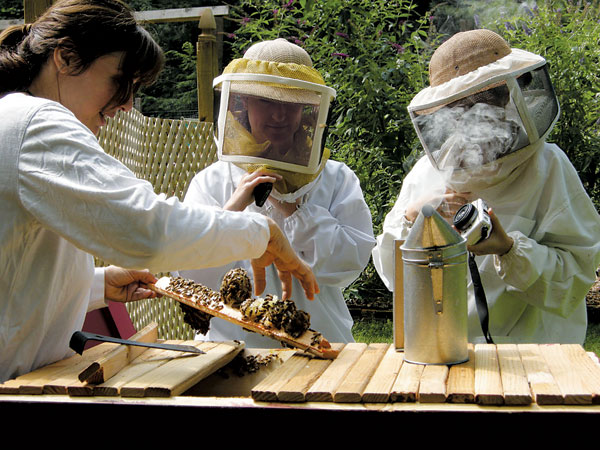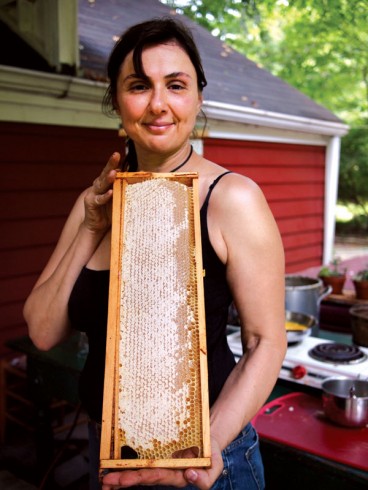
In 1999 Marina Marchese quit her job as creative designer for a small giftware company in New York City and settled into a more rustic routine at her little red cottage in Weston, Connecticut. Tired of commuting into the city and passionate about her new backyard beekeeping hobby, Marina decided to start a business based on her bees and the delicious honey they produced. With only limited savings, the artistic and free-spirited Marina worked odd jobs in catering and dog sitting to help pay the bills while she tended her first few hives.
Marina, then 37, was still a “new-bee,” as novice beekeepers are known. But she wanted to be the queen bee, so she studied every aspect of this industrious insect, from its fascinating social life inside the hive to the many varieties of honey it was capable of producing. She attended meetings at local beekeeper clubs and even traveled to England and Italy where honey tasting is on par with wine tasting.
It’s safe to say that artisanal beekeepers like Marina go to extremes, but the honey they produce is a far cry from the kind that you buy in a plastic-molded teddy bear bottle. Artisanal honey making emphasizes quality and character over quantity and consistency. To produce the finest honey, beekeepers become micromanagers of their honeybees, scouting optimal field locations, knowing when nectar flow begins, and selecting the best ways to extract honey when the season is done.
Beekeeping may seem like a dramatic departure from a career in design, but the passion and creativity Marina brought to her business were nothing new. Growing up, she knew she wanted to create art, but spent her childhood rebelling against parents who didn’t support her artistic nature. “I was this creative kid growing up in a corporate family,” Marina says. “My mother was always pushing me to go to college to study business. Creativity just wasn’t nurtured, and it certainly wasn’t treasured.
“As a kid I always doodled—and I always got in trouble. I doodled in cookbooks, on the walls, in the closet, and behind doors where my parents wouldn’t see it. I remember soaking in the tub as my grandma scrubbed ink off my legs because I doodled all over my body.”
A series of seemingly unconnected events brought Marina to beekeeping. In the late 1990s a neighbor saw her illustrations of bee characters—including a sassy queen bee—and invited Marina to check out his backyard hive of Italian honeybees. Unsure at first, Marina put on the beekeeper’s hat and veil and watched as her neighbor opened the hives. “I was mesmerized,” she says. “The bees were so well-behaved, but I kept thinking they were going to swarm and sting. That day I tasted fresh honey and was smitten.”

She bought her first hive through mail order and tended bees on weekends. During the week she took the train to her job in the city. Some days she would cry because she was so unhappy with her job and the commute. One day Marina pulled a paperback novel, The Beekeeper’s Apprentice, from the borrowing rack at the train station. She took this accidental find as a sign that beekeeping was going to play a much larger role in her life. From that day forward she took greater interest in her hobby, joining bee clubs, reading books, and attending workshops.
Within two years honey from her first hive was ready for harvesting. Rather than give her honey away, as many backyard beekeepers do, Marina designed bottles with beautiful labels and prepared to sell her small first batch of 12 bottles at the local farmer’s market. She encountered some resistance from shoppers who weren’t quite sold on the idea of paying premium prices for something that has traditionally been a commodity.
“I pretty much starved that first winter,” she says. “I told myself, ‘I am talented, and I am going to survive.’ When I get interested in something, I go into it deeply. I had only scratched the surface of this amazing creature and wanted to know more.”
To survive she expanded her product line, selling beeswax lip balm and honey-based skin care products such as handmade soaps, facial scrubs, and foot rubs. And, taking full advantage of the bee’s bounty, Marina started to feed her artistic soul by painting with heated beeswax in a technique known as encaustic painting. About five years ago—and a full seven years after starting her business—Marina reached a financial milestone. She no longer had to work odd jobs to help pay her bills. Today Marina’s company, Red Bee Apiary, harvests approximately 100 gallons of honey per year, and is a favorite of regional chefs and gourmands alike. Demand is greater than supply, so she works with local beekeepers who meet her exacting criteria for artisanal honey to boost production.
Like a convert to a new religion, Marina wants others to share her passion for artisanal honey. She travels around the country talking to beekeeper groups and sponsors tastings at her apiary. She even wrote a book, Honeybee: Lessons from an Accidental Beekeeper, which encompasses not just her personal story but the history of beekeeping, bee behavior, tips for would-be backyard beekeepers, and the many ways honey can be used in food and healthy living. “My business brings together everything I’ve worked for in my life,” says Marina. “When you’re doing something you’re meant to do, everything just falls into place.”
- One pound of honey contains the concentrated essence of about 2 million flowers.
- Roughly 60,000 honeybees populate a single hive.
- Collectively, bees travel about 55,000 miles for each pound of honey.
- Eighty percent of the pollination of the fruits, vegetables, and seed crops in the U.S. is done by honeybees.
- There are more than 300 unique, single-varietal honeys in the U.S.
- Honeybees have five eyes.
- Honey stored in air tight containers never spoils. Sealed honey vats found in King Tut’s tomb contained edible, 2,000-year-old honey.
- A queen bee can lay up to 2,000 eggs per day.

Become a Saturday Evening Post member and enjoy unlimited access. Subscribe now




Comments
In the enjoyment of reading of Marina Marchese’s venture with bees, I reflected upon my own venture as a high school kid, trying a hive on a 25 foot lot in downtown Grand Rapids, MI. After ordering four or five pounds of bees with a queen, they not only passed the test of survival on a city lot, but replicated to a full, busy colony and that first year produced two supers ( 56 pounds). My siblings and I, and even my dad who originally had forbid it, spent many enjoyable minutes (or hours) sitting and watching those little creatures exit the hive, do three circles and take off to what ever parking lot or garden they were pollinating on that day.
That was back in ’48 or ’49. I kept them until Uncle Sam invited me to get on a bus for induction and I had to wrap them up for a trip to my uncle in the country. Marina’s venture was the fruit of lucid vision.